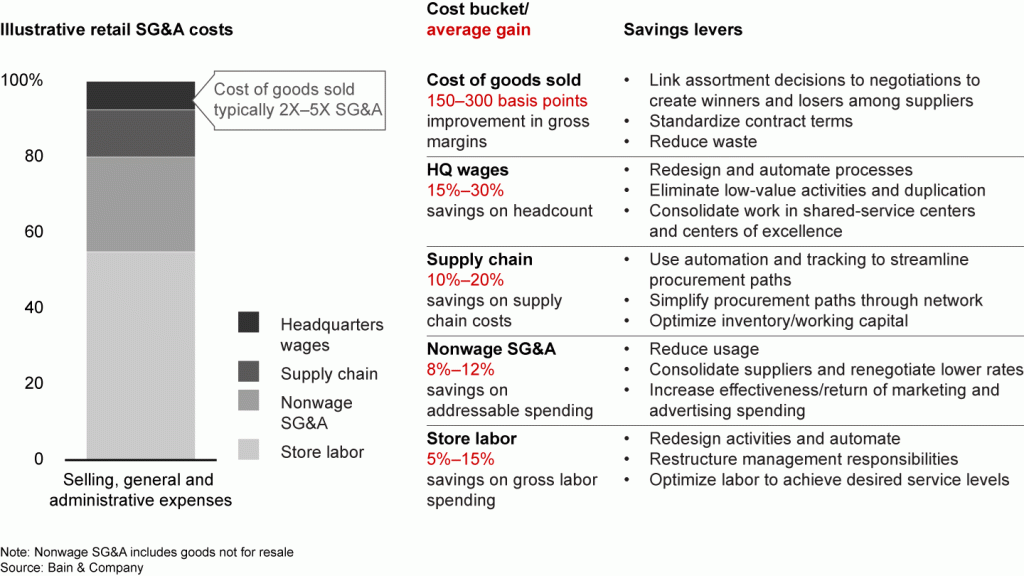Unlock Incredible Retail Cost Savings Now: Your Ultimate Click-to-Action Solution!
Retail Cost Savings: How to Optimize Your Expenses and Boost Profitability
Introduction
Dear Readers,
2 Picture Gallery: Unlock Incredible Retail Cost Savings Now: Your Ultimate Click-to-Action Solution!


Welcome to our comprehensive guide on retail cost savings. In today’s competitive business landscape, managing expenses effectively is crucial for the success and sustainability of any retail operation. By optimizing costs, businesses can increase their profitability, improve customer experience, and stay ahead of the competition.

Image Source: bain.com
In this article, we will explore various strategies and tactics to help you reduce costs without compromising on quality or customer satisfaction. Whether you run a small boutique or a large chain of stores, these insights will prove invaluable in your quest to maximize profitability.
So, let’s dive in and discover the secrets of successful retail cost savings!
Table of Contents
1. What is Retail Cost Savings?

Image Source: bain.com
2. Who can Benefit from Retail Cost Savings?
3. When to Implement Cost-Saving Measures?
4. Where to Look for Opportunities to Save?
5. Why is Retail Cost Savings Important?
6. How to Achieve Retail Cost Savings?
7. Advantages and Disadvantages of Retail Cost Savings
8. Frequently Asked Questions (FAQ)
9. Conclusion
10. Final Remarks
1. What is Retail Cost Savings?
Retail cost savings refer to the strategies and practices employed by retailers to reduce expenses without compromising the quality of products or services offered. It involves identifying areas of unnecessary spending, negotiating better deals with suppliers, optimizing inventory management, and implementing efficient operational processes.
By implementing effective cost-saving measures, retailers can increase their profit margins, reinvest in their business, offer competitive pricing to customers, and enhance overall financial performance.
2. Who can Benefit from Retail Cost Savings?
Retail cost savings are relevant to businesses of all sizes and types operating in the retail industry. Whether you are a small independent retailer or a multinational chain, optimizing costs is essential for ensuring long-term success and growth.
Furthermore, cost savings strategies are not limited to specific sectors within retail. They can be applied across various categories, including fashion, electronics, home decor, grocery, and more.
Regardless of the nature of your retail business, implementing cost-saving measures can help you stay competitive, improve financial stability, and create a solid foundation for future growth.
3. When to Implement Cost-Saving Measures?
The ideal time to implement cost-saving measures is as soon as possible. It is never too early or too late to start optimizing your expenses. However, it is crucial to regularly evaluate your cost structure and identify potential areas for improvement.
Some common triggers for implementing cost-saving measures include:
Significant fluctuations in the market or economic conditions
Increased competition
Rising supplier costs
Changes in consumer behavior
Expansion or diversification of the business
By staying proactive and monitoring the market and internal operations, you can identify cost-saving opportunities and act swiftly to optimize your expenses.
4. Where to Look for Opportunities to Save?
Cost-saving opportunities can be found in various aspects of your retail business. Some areas to consider when looking for opportunities to save include:
Supply chain management and procurement
Inventory management and control
Energy consumption and utility expenses
Store layout and visual merchandising
Staffing and labor costs
Technology and automation
Marketing and advertising expenditures
By conducting a thorough assessment of these areas and implementing targeted cost-saving initiatives, you can significantly improve your bottom line.
5. Why is Retail Cost Savings Important?
Retail cost savings play a crucial role in the success and sustainability of any retail business. Here are some key reasons why retail cost savings are important:
Increased Profitability: By reducing expenses, retailers can increase their profit margins, resulting in higher profitability.
Competitive Advantage: Cost savings allow retailers to offer competitive pricing, giving them an edge over their competitors.
Business Expansion: By optimizing costs, retailers can allocate resources towards business expansion and growth initiatives.
Improved Financial Stability: Effective cost savings lead to improved financial stability, allowing retailers to weather economic uncertainties.
Enhanced Customer Experience: Cost savings can be reinvested in improving customer experience through better products, services, and overall shopping environment.
By recognizing the importance of retail cost savings, businesses can make informed decisions to drive long-term success.
6. How to Achieve Retail Cost Savings?
Achieving retail cost savings requires a systematic and strategic approach. Here are some steps to help you get started:
Analyze Your Expenses: Conduct a comprehensive review of your expenses to identify areas of potential cost savings.
Negotiate with Suppliers: Seek better deals and negotiate favorable terms with your suppliers to reduce procurement costs.
Optimize Inventory Management: Implement effective inventory management practices to avoid overstocking and minimize carrying costs.
Streamline Operations: Identify and eliminate inefficiencies in your operational processes to reduce labor and other related expenses.
Embrace Technology: Leverage technology to automate manual tasks, streamline operations, and improve overall efficiency.
Train and Empower Employees: Invest in training programs to enhance employee productivity, reduce errors, and minimize costs associated with turnover.
Monitor and Measure: Continuously monitor and measure the impact of your cost-saving initiatives to ensure they are delivering the desired results.
By implementing these strategies and tailoring them to your specific business needs, you can achieve sustainable retail cost savings.
7. Advantages and Disadvantages of Retail Cost Savings
Like any business strategy, retail cost savings come with their own set of advantages and disadvantages. Let’s explore both sides:
Advantages
1. Increased Profit Margins: By reducing expenses, retailers can increase their profit margins, leading to higher profitability.
2. Competitive Pricing: Cost savings allow retailers to offer more competitive pricing, attracting price-sensitive customers.
3. Business Growth: Optimizing costs frees up resources that can be invested in business expansion and growth initiatives.
4. Financial Stability: Effective cost savings provide a buffer against economic uncertainties, ensuring financial stability.
5. Improved Operations: Cost-saving measures often result in streamlined operations and improved efficiency.
Disadvantages
1. Potential Quality Compromise: Cutting costs indiscriminately may lead to compromises in product quality or customer experience.
2. Supplier Relationships: Negotiating better deals with suppliers may strain relationships, impacting future collaborations.
3. Initial Investments: Some cost-saving initiatives may require upfront investments, impacting short-term cash flow.
4. Resistance to Change: Implementing cost-saving measures may face resistance from employees who are resistant to change.
5. Market Perception: Drastic cost-cutting measures without careful consideration can negatively impact a brand’s image.
It is essential to weigh the advantages and disadvantages before implementing retail cost savings strategies to ensure a balanced approach.
8. Frequently Asked Questions (FAQ)
1. Is it possible to achieve retail cost savings without compromising the quality of products or services?
Yes, it is possible to achieve retail cost savings without compromising quality. By adopting a strategic and targeted approach, retailers can identify areas of potential savings while maintaining high standards.
2. How long does it take to see the results of cost-saving initiatives?
The timeframe for seeing results from cost-saving initiatives varies depending on the nature of the initiative and the specific business. Some initiatives may yield immediate results, while others may take longer. It is crucial to monitor and measure the impact regularly to ensure effectiveness.
3. Are there any specific cost-saving strategies for online retailers?
Yes, online retailers can implement various cost-saving strategies such as optimizing website performance, streamlining logistics and fulfillment processes, leveraging data analytics, and adopting efficient customer service channels.
4. Should cost-saving measures be implemented during economic downturns only?
While economic downturns may necessitate a heightened focus on cost-saving measures, it is advisable to implement them regardless of the economic conditions. Proactive cost management ensures a resilient and agile business that can navigate uncertainties effectively.
5. Can cost-saving measures help improve sustainability and environmental impact?
Absolutely. Retail cost-saving measures often align with sustainability initiatives, such as reducing energy consumption, minimizing waste, and adopting eco-friendly practices. By implementing such measures, retailers can reduce their environmental footprint while cutting costs.
9. Conclusion
In conclusion, retail cost savings are essential for the success, profitability, and sustainability of any retail business. By implementing effective strategies and practices, retailers can optimize expenses without compromising on quality or customer experience.
Remember to regularly assess your cost structure, identify areas for improvement, and implement targeted cost-saving initiatives. By doing so, you can increase your profit margins, stay competitive, and create a solid foundation for long-term growth.
Thank you for joining us on this journey towards achieving retail cost savings. We hope you found this guide informative and actionable.
Good luck in your cost-saving endeavors!
10. Final Remarks
Friends,
While the information provided in this article is based on extensive research and industry knowledge, it is important to note that every retail business is unique. The strategies and tactics outlined here may need to be tailored to your specific needs and circumstances.
Additionally, market conditions and industry trends are constantly evolving, so it is crucial to stay updated and adapt your cost-saving initiatives accordingly.
Remember, achieving retail cost savings is an ongoing process that requires constant evaluation, innovation, and a keen focus on your business goals.
Wishing you success in your pursuit of retail cost savings!
This post topic: Shopping Savings


